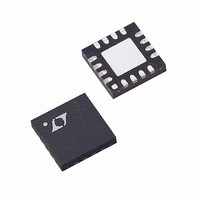LT3755EUD-2#TRPBF Linear Technology, LT3755EUD-2#TRPBF Datasheet - Page 12

LT3755EUD-2#TRPBF
Manufacturer Part Number
LT3755EUD-2#TRPBF
Description
IC LED DRVR HP CONST CURR 16-QFN
Manufacturer
Linear Technology
Type
High Power, Constant Currentr
Datasheet
1.LT3755EUD-2TRPBF.pdf
(26 pages)
Specifications of LT3755EUD-2#TRPBF
Constant Current
Yes
Constant Voltage
Yes
Topology
Flyback, Low Side, PWM, SEPIC, Step-Down (Buck), Step-Up (Boost)
Number Of Outputs
1
Internal Driver
No
Type - Primary
Automotive
Type - Secondary
White LED
Frequency
100kHz ~ 1MHz
Voltage - Supply
4.5 V ~ 40 V
Voltage - Output
75V
Mounting Type
Surface Mount
Package / Case
16-WQFN Exposed Pad
Operating Temperature
-40°C ~ 125°C
Current - Output / Channel
1A
Internal Switch(s)
Yes
Lead Free Status / RoHS Status
Lead free / RoHS Compliant
Efficiency
-
Available stocks
Company
Part Number
Manufacturer
Quantity
Price
LT3755/LT3755-1/LT3755-2
When V
regulated to:
The LED current programming feature can increase total
dimming range by a factor of 10. The CTRL pin should
not be left open (tie to V
can also be used in conjunction with a thermistor to
provide overtemperature protection for the LED load, or
with a resistor divider to V
switching current when V
varying differential voltage signal (ripple) across ISP and
ISN at the switching frequency is expected. The amplitude
of this signal is increased by high LED load current, low
switching frequency and/or a smaller value output filter
capacitor. Some level of ripple signal is acceptable: the
compensation capacitor on the VC pin filters the signal so
the average difference between ISP and ISN is regulated
to the user-programmed value. Ripple voltage amplitude
(peak-to-peak) in excess of 20mV should not cause mis-
operation, but may lead to noticeable offset between the
average value and the user-programmed value.
Programming Output Voltage (Constant Voltage
Regulation) or Open LED/Overvoltage Threshold
For a boost application, the output voltage can be set by
selecting the values of R3 and R4 (see Figure 2) according
to the following equation:
For a boost type LED driver, set the resistor from the output
to the FB pin such that the expected V
applicaTions inForMaTion
I
V
LED
OUT
=
CTRL
= 1.25 •
Figure 2. Feedback Resistor Connection for
Boost or SEPIC LED Driver
100mV
R
LED
is higher than 1.2V, the LED current is
R3 + R4
R4
LT3755
IN
REF
FB
IN
is low. The presence of a time
to reduce output power and
if not used). The CTRL pin
V
OUT
R3
R4
37551 F02
FB
during normal
operation will not exceed 1.1V. For an LED driver of buck or
a buck-boost configuration, the output voltage is typically
level-shifted to a signal with respect to GND as illustrated
in Figure 3. The output can be expressed as:
ISP/ISN Short-Circuit Protection Feature (for SEPIC)
The ISP and ISN pins have a protection feature indepen-
dent of the LED current sense feature that operates at
ISN below 3V. The purpose of this feature is to provide
continuous current sensing when ISN is below the LED
current sense common mode range (during start-up or
an output short-circuit fault) to prevent the development
of excessive switching currents that could damage the
power components in a SEPIC converter. The action
threshold (150mV, typ) is above the default LED current
sense threshold, so that no interference will occur over
the ISN voltage range where these two functions overlap.
This feature acts in the same manner as SENSE current
limit — it prevents GATE from going high (switch turn-on)
until the ISP/ISN difference falls below the threshold. If the
load has appreciable series inductance, use of a Schottky
clamp from GND to ISN is recommended for the SEPIC
to prevent excessive current flowing from the ISN pin in
a fault.
Dimming Control
There are two methods to control the current source for
dimming using the LT3755. One method uses the CTRL pin
to adjust the current regulated in the LEDs. A second method
uses the PWM pin to modulate the current source between
V
OUT
LT3755
Figure 3. Feedback Resistor Connection for
Buck Mode or Buck-Boost Mode LED Driver
= V
BE
FB
+ 1.25 •
R3
R4
R3
R4
+
–
V
OUT
100k
R
SEN(EXT)
LED
ARRAY
37551 F03
C
OUT
37551fd














